Move over Nautilus, here comes Nereus. The fictional Captain Nemo piloted his submarine Nautilus 20,000 leagues under the sea. But Nereus, a hybrid, remotely operated vehicle (HROV), will enable real scientists to explore the deepest areas of the ocean. For example, the Challenger Deep section of the Mariana Trench—35,838 feet below sea level—was visited very briefly four decades ago by pioneering oceanographers. Technology limitations have prevented routine access to these remote regions, and they have not been explored in detail—until now.
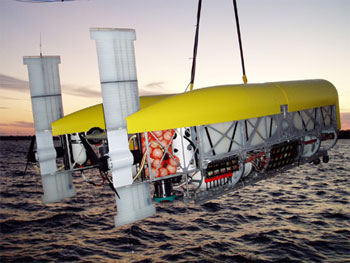 |
| Fig. 1: The Nereus Hybrid Remote Operating Vehicle can conduct scientific researchwhile tethered to the ship or while swimming freely. It can carry a 25 kg payload for collecting core, rock, biological and water samples, measure temperature and take still and video images. To control Nereus, scientists can send signals via a fiber optic cable similar to a torpedo wire; 35,000 ft. cable fit on a spool that’s about the same size a 60-lb. spool of welding wire.
|
Nereus’ name is taken from Greek mythology, where he was one of the manifestations of “the old man of the sea.” Nereus (rhymes with “serious”) was the eldest son of Pontus and Gaia (the Earth and the Sea). The Nereus HROV (see Fig. 1) has a more worldly origin; Woods Hole Oceanographic Institution (WHOI) of Falmouth, Mass., designed and fabricated it.
WHOI is a private, independent organization dedicated to marine research, engineering and higher education. Its primary mission is to understand the oceans and their interaction with the Earth as a whole, and to communicate a basic understanding of the ocean's role in the changing global environment. WHOI is world-renowned for its deep-sea submersible vehicle Alvin, which is most famous for exploring the wreck of the Titanic.
Nereus, whose development was funded by National Science Foundation, must be capable of working under intense pressure. At Challenger Deep, the water exerts a pressure of 15,751 psi, or more than one thousand times the atmospheric pressure at sea level. Needless to say, weld quality is critical.
 |
|
Fig. 2: Geoff Ekblaw, senior welder at the Woods Hole Oceanographic Institution (WHOI), brought more than 30 years of welding experience to the Nereus project. His career includes TIG welding the aluminum hull of numerous 12-meter yachts for the America’s Cup race.
|
After using a Syncrowave® 350 LX AC/DC TIG welder from Miller Electric Mfg. Co. to weld Nereus’ aluminum frame, Geoff Ekblaw (Fig. 2), WHOI’s senior welder, took a few moments to describe his work and provide some helpful fabrication advice. Prior to joining WHOI in 1996, Ekblaw’s welding career included blacksmithing, metal sculpture, bridge work, military and defense welding and more than 20 years of fabricating aluminum boats for the America’s Cup race, including boats for the legendary Dennis Connor and the New York Yacht Club.
Keeping it Straight
The basic Nereus design calls for two rectangular-shaped pods joined by a center section (see background of Fig. 3). The center section is simply an 86 in. piece of schedule 80 6061-T6 aluminum pipe. 6061-T6 plate, in thicknesses from 1/4- to 3/4-in., forms the skeleton of the 160-in.-long pods.
When working with aluminum, Ekblaw says, “The question is: When you weld it, can you keep it straight? I had a lot of experience doing that with the 12-meter America’s Cup yachts. We had to hold tolerances to 1/32 of an inch, and we did that by equalizing the heat input. It’s just like putting torque on a car’s header; you have to evenly distribute the pressure.”
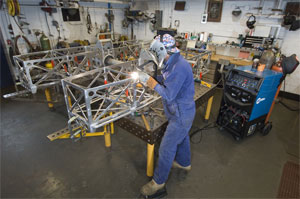 |
| Fig. 3: Geoff Ekblaw finished welding the aluminum frame of Nereus in May 2007 using a Syncrowave 350 LX TIG welder. One of Nereus’ missions is to explore Challenger Deep, some 36,000 ft. below sea level, where pressures exceed 15,750 psi.
|
Nereus’ designers also demanded holding alignment to 1/32 in. on a centerline. To accomplish this, Ekblaw started by using a high-tolerance, modular fixturing table. The table provides accuracy because the bores holding the clamps and associated tooling have a tolerance of ±0.001; all table elements are machined flat and square to a tolerance of 0.004 in.
To maintain part tolerance, WHOI uses an abrasive water jet to cut all of its materials. Depending on the model, a water jet typically cuts parts to within tolerances of ± 0.003 to 0.001 in., leaves no dross on the backside of the cut and creates no heat affected zone or warping to affect fit-up.
Once cut, “The sections of aluminum fit together like a Lego® puzzle,” says Ekblaw. WHOI engineers developed a design where all the pieces mechanically interlock with slots and tabs. When fitted into a slot, each tab has a “shoulder” that creates an absolute dead stop. The end of the tab fits perfectly flush with the outside of the slot (Fig. 4).
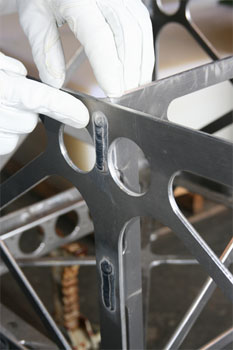 |
| Fig. 4: All joints on Nereus mechanically interlocked with a tab-and-slot design. This promoted excellent part fit-up and promoted overall part alignment.
|
All welds required 100 percent penetration (Fig. 5), so the WHOI fabrication team used routers and carbide cutters to bevel every joint. “It took us days of routing,” says Ekblaw, “but good weld quality demands good weld preparation.”
Key Welding Variables
Another key part of the preparation was selecting the right filler wire. Instead of using the more traditional choice of filler wire for welding 6061-T6 aluminum, 4043, Ekblaw says he, “elected to use 4643 aluminum filler wire because it has a lower silicon content and therefore less chance of cracking.” Ekblaw learned about this tech tip during an aluminum technical conference at the 2006 AWS/FABTECH show in Atlanta, saying, “Those organizations answer a lot of questions” (http://www.aws.org/show/ and http://www.fmafabtech.com/).
For welding thick sections of aluminum at 200 to 250 amps using a conventional squarewave technology, Ekblaw selected a 5/32-in. diameter pure tungsten. The high output/high duty cycle welding on Nereus required a water-cooled TIG torch (Fig. 6), which he outfitted with a size 7 or 8 alumina cup and a gas lens. A gas lens ensures smooth, even distribution of the argon shielding gas. This prevents turbulence that could pull in atmospheric contaminates, and Ekblaw won’t make critical TIG welds without one.
Mind the Heat
To start welding, Ekblaw tacked every joint, evenly distributing heat around Nereus. He then locked Nereus to the fixturing table and began welding, again evenly distributing the heat by shifting between the port and starboard sides and making shorter welds.
 |
| Fig. 5: To ensure 100 percent penetration even on 3/4 in.-thick sections such as this, Ekblaw beveled all joint edges. Nereus required about 35 lbs. of filler wire to complete.
|
Unlike welders who leave a TIG machine’s balance control set in one spot, Ekblaw uses the Syncrowave’s AC balance control (see Fig. 7) to adjust the ratio of cleaning action (duration of the electrode positive half cycle) to penetration (duration of the electrode negative half cycle, where the heat flows from the tungsten into the workpiece).
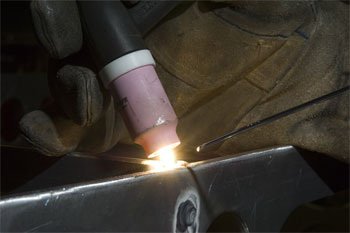 |
| Fig. 6: Nereus required 80 to 100 hours to weld at amperages of 125 to 250 amps. For high duty cycle, high temperature welding, a water-cooled TIG torch like this one increases operator comfort.
|
“I really like Miller squarewave machines because of their balance control,” he says. “I make constant adjustments. As the heat builds up, I turn down the penetration. If I see the weld puddle is a little cold, I turn up the heat.” On a Syncrowave, a balance control setting of 1 provides maximum cleaning, while a setting of 10 provides maximum penetration. A setting of 7 is a good starting point for most applications.
Ekblaw only welded in the flat, horizontal or vertical-up position, moving Nereus’ frame as necessary. “I think vertical up helps ensure good fusion, and I can see the joint better. With vertical down, I would be worried about the puddle rolling over the top of the joint and causing cold lap,” says Ekblaw.
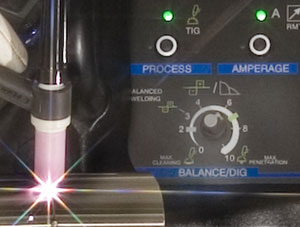 |
| Fig. 7: When making long aluminum welds, Ekblaw doesn’t just leave his balance control in one position. Typically, he’ll turn the balance control down to after the weldment heats up.
|
Despite Ekblaw’s best efforts, distortion occurred. “The center pipe shrunk 3/4 in. I could see from the center line that my layout was perfect, but welding caused the pipe to shrink 1/2 in., and heat treating caused it to shrink another 1/4 in. Fortunately, the distance between the two pods doesn’t affect the design. Our primary goal was keeping the pods parallel, which we achieved,” he says.
Welding heat also created an “old fashioned oil can” problem. The smaller sections on the bottom of the pods were designed with an X configuration (see Fig. 8) had insufficient mass to dissipate the heat of welding. They subsequently popped out of plane (imagine trying to fit a 20-in metal strip into a space only 19.75 inches wide…you would need to slightly bend the strip to fit it in place).
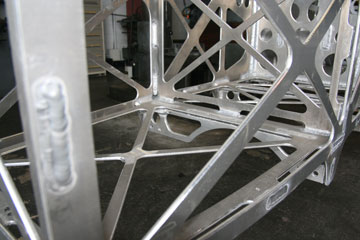 |
|
Fig. 8: Some sections with this X configuration “oil canned” during welding. See Fig. 9 for the solution.
|
“On the sections that oil canned, I cut out a small piece of the center section and rewelded the halves,” says Ekblaw (see Fig. 9). “As the weld cooled, it shrunk the section and put the part back into true.”
Overall, Ekblaw says it took him 80 to 100 hours to weld the "pipe" main cross member, the two outside frames and the manipulator arm sled, using about 35 lbs. of filler rod in the process.
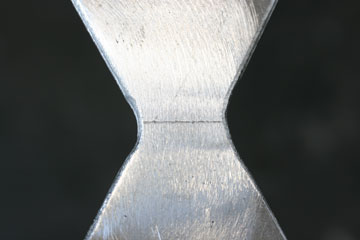 |
| Fig. 9: To eliminate oil canning, Ekblaw removed a small section of metal from the center section and filled the gap with a 100-percent penetration weld, shown here. As the weld cooled, it pulled the metal tight and eliminated the oil canning.
|
“We work our welding machines hard—sometimes 50 to 60 hours per week,” says Ekblaw. “Some of our Miller TIG machines are 10 or 15 years old, and they still work. When we needed a new welder with a higher output for welding the thick aluminum on Nereus, went with what works: Miller.”